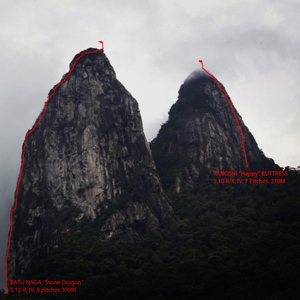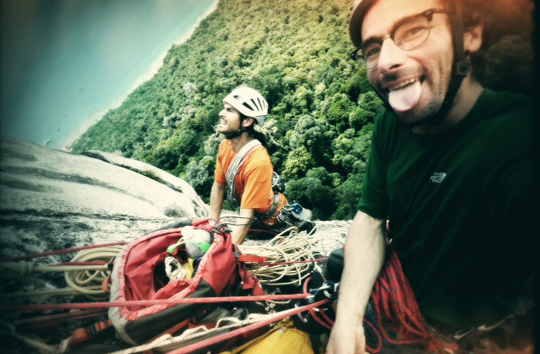
Malaysia’s Dragon’s Horns. The routeline’s show the two new climbs done by Luis “Lucho” Rivera and Cedar Wright. The pair made the first ascent of the north tower (right) via the Tanoshi Buttress (5.10 R/X, 270m) and the route Batu Naga (5.12R, 300m) on the south tower (left). [Photo] Cedar Wright
On a climbing trip that was partially planned on Facebook, Luis “Lucho” Rivera and Cedar Wright put up two new routes on the Dragon’s Horns on Malaysia’s Tioman Island: Tanoshi Buttress (5.10R/X, 270m) marks the first recorded ascent of the Horns’ north tower, and Batu Naga (5.12R 300m) climbs “one of the proudest looking lines on the entire formation” up a prominent buttress on the south tower.
Wright heard about the formation from Scotty Nelson, who did the first ascent of the south tower in 1999 and recommended it as a great adventure, Wright said. (Read more about Tioman’s climbing history in the November 24, 2009 NewsWire and the June 8, 2011 NewsWire.) “Then I got online and saw the video from David Kaszlikowski’s trip and started doing some more Internet research.” Wright invited Rivera, an old friend from Yosemite who he describes as, “Someone who is always ready for an adventure.”
On their first full day in Malaysia, the pair put up their new line on the unclimbed north tower. For the first 700 hundred feet, the two climbed “classic,” exposed granite and through two of rainstorms before reaching the final few hundred feet of vegetated fourth class.
With the sun setting as they reached the summit, the pair decided to sleep through the night and descend in the morning, but torrential thunderstorms caused them to rethink this decision, and around 3 a.m. they began the four hours of rappelling to reach their starting point in the jungle.
With one climb in the bag, Rivera and Wright turned their attention to the south tower of the Dragon’s Horns. First climbed in 1999, this Horn has seen at least eight previous ascents by local and foreign climbers.
On the approach, imprecise beta kept Rivera and Wright busy bushwacking and backtracking through the jungle as they struggled to reach the walls.
“The jungle in Tioman Island is pretty treacherous, with heinous spiky ferns dripping spiny tendrils that manage to consistently grab your clothing and skin as you attempt to weave through unscathed!” Wright wrote in his blog. “We passed all kind of heinous creepy crawlies: ants the size of my thumbnail, angry monkeys, a black snake that we later learned was a poisonous pit-viper, bizarre frogs, and this oddness all highlighted by the constant screech of mysterious bugs (or were they birds?).”

Rivera and Wright on Batu Naga, a new line they climbed on the south tower of the Dragon’s Horns. [Photo] Cedar Wright
The duo finally spotted the remains of a camp at the base of the wall, possibly that of Steve Beckwith and Matt Travers from 2009. Above them stretched the 300m south face of the Malaysian tower, a face that started with “a wild corner that lead to a series of impressive roofs.” Wright started leading, sometimes choosing harder sections in favor of wasp infested, but technically easier climbing. The first few pitches looked like 5.12, but were a grade easier.
Rain sent Rivera and Wright back to the base after they fixed ropes. Over the next five days, the pair alternated between pushing the climb higher and waiting in their cabin for the rain to stop. In the process, they turned the four-and-a-half-hour jungle bushwack into a more reasonable hour-and-a-half trek.
After four days, a final section of overhanging tufa climbing lead into easy climbing, vertical grass ledges and the summit. Happy with their stellar climbing the two enjoyed the view before descending back and preparing for a free ascent of the route the next day. Of the climb itself Wright writes, “It was hard to believe just how good the climb we had just put up was. I equate it to going to Yosemite and doing the first ascent of Astroman, or going to Squamish and doing the University Wall. ”
As usual the rain forestalled any plans made by the climbers. After three days of rain, Rivera and Wright returned and freed the route in five and a half hours, giving it a grade of 5.12R. The duo warn future climbers to be ready for big runouts on rock up to 5.10 and recommend a creative approach to protection, including shallow cams, weird R.P. placements and slung knobs and flakes. Sections harder than 5.11 are relatively well protected.
Besides the great climbing presented by the Dragon’s Horns the routes are special to Rivera and Wright for other reasons as well. Though an accomplished Yosemite climber, this was Rivera’s first international climbing experience. Furthermore, the climb is/was a fundraiser for Big City Mountaineers, a non-profit that brings under-resourced urban youth into the great outdoors. Rivera found this especially important, as a teen group similar to BCM took him out on a backpacking trip that he credits with giving him his first taste of nature.
Rumble in the Jungle: Part One, The Unclimbed Horn from Cedar Wright on Vimeo.